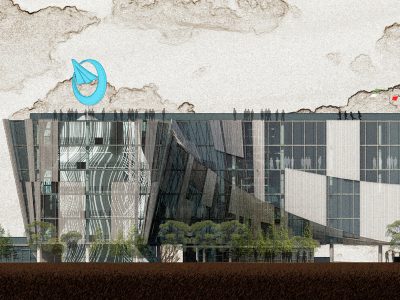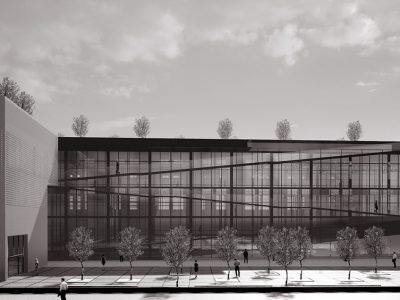Design Concept
The design concept is actually emulating the Yangshan Mountain in the background and thus the 2 building tops that signifies mountain shape as rooftops. The gradiation of colours from red top to black bottom signifies sunrise colour reflecting on the mountain while the black top to red bottom signifies sunset colour.
Building concept, spatial flow and material used
The façade is made of terracotta plays a tremendous part in a building’s energy footprint . The whole building mainly consist of terracotta blocks for first layer to decorate the facade of the building. The internal wall which is the second layer is made of concrete blocks with iron infrastructure.
Benefits of terracotta for bio-climatic design:-
- Environmentally friendly – It is 100% natural and recyclable. Because of its production process, it is characterized by being environmental-friendly and with low energy consumption.
- Safety and shock resistance, acid and alkali resistance – Terracotta is made of natural clay, containing no radioactive elements
- Maintenance free & durable
- It is non-combustible and resistant to impact
- Because of its low-thermal diffusivity, it contributes to a stable and comfortable indoor temperature during summer and it is frost-resistant during winter.
- It has natural sound absorption properties, thus making it an effective noise attenuator.
- Its unique colors are UV resistant and will not change over time.
- Easy to install (and remove if necessary) because it is individually replaceable cladding elements
- Lightweight – enabling a reduced structural costs (from 27kg/m2)
- Last but not least terracotta are cost effective when it comes to building two big buildings.
This project basically consist of two buildings and Building 1 is facing south and Building 2 is facing north which has the view of Yanshan Mountain. The two buildings are inter-connected with 2 bridges on each floor for easy access on both ends and also every floors.
Building 1 mainly consist of Classrooms and Administration while Building 2 has Audio Visual area and Exhibition area incorporated inside. The main entrance comes from the east and west of the building and on the east side, there is near 2 subway stations nearby and the main traffic comes from the east road.
There is a passageway in between the 2 buildings to allow for ventilation of air to spaces to the 2 buildings. There is a east coast sea nearby and there will be sea wind blowing to ventilate the spaces well. In the middle of the building, there is a courtyard for common area where people can use as a meeting point or to catch fresh air.
Level B1 – consist of Gymnasium and Dining Area where organic food is served.
Level 1 – this is the public space for Common Area where half of the space is planted 6 particular air- purifying plants all around to purify the air for the building from the pollution and dust and therefore provide more oxygen for inhabitants. With Beijing 120km nearby and Tianjin as an industrial area, the whole building will need natural air purifier.
This level also hosts Lecture Hall / Classrooms and Exhibition Halls as well. Besides these areas, there are also AV Rooms and Directional Area.
Level 2 – consists of open offices where there are Reading Rooms, Resting Rooms and Meeting Rooms for internal staffs. This area is built with wooden loft for offices in between the floor and ceiling space as the ceiling height is very high.
Level 3 – consists of independent and private office area where outsiders can rent the office spaces. The area also has the same areas as Level 2 for Reading Rooms, Resting Rooms and Meeting Rooms as well as loft space for more offices.
Level 4 – consist of Vegetable Garden Terrace, Research space and solar panels space. This is the area where the Plant-e technology will be cultivated to generate power to the building. Besides having the Plant-e technology, there will be a garden for “home-grown” vegetables for restaurant at the basement to serve organic food to the inhabitants or they are also encouraging to cultivate the habit of growing their own vegetables. Air-purifying plants will also be grown on the rooftop to purify the air pollutants.
The Research Area will also be placed here together with the solar system panels where the solar power can be captured easily to generate electricity for the buildings.
A bio-climatic building is designed in a way that allows occupants to benefit from the environmental sources. Basic elements of bioclimatic design are passive solar systems which are incorporated onto buildings and utilize environmental sources (for example, sun, air, wind, vegetation, water, soil, sky) for heating, cooling and lighting the buildings. Passive solar systems function without mechanical parts or additional energy supply and are used for heating as well as cooling buildings naturally. Passive solar systems are divided into three categories:
Passive Solar Heating Systems
These 2 buildings are designed to use solar energy for heating buildings in the winter season and for daylighting all year round. This is achieved by having the building orientation facing south / north which collect solar radiation and act as “natural” heating as well as lighting systems. The exterior walls are designed in a way to allow natural light to lit up the internal spaces. There is also a protection of the buildings from the summer sun by using terracotta external layer as shading to avoid over heating from the heat and glare of the light. In addition to this, the whole of 4th floor rooftop will install solar panels to help in generating power to the buildings thus reducing electricity consumption in long run. There will also be planting area for Plant-e that generate natural power together with solar panel. While the plant is growing, electricity is produced.
Passive Cooling Systems
The 2 buildings are also designed to use natural ventilation by having an external layer of terracotta blocks. Terracotta is known for its capacity for cooling in hot climate; the ventilated walls will lessen the thermal shocks in the internal concrete walls. Terracotta is able to absorb solar heat during the day and re-emitting heat to the outside during the night thereby reducing the heat transmittance into the building through the glass windows
There is a passageway incorporated in between the 2 buildings to allow natural ventilation from the nearby sea wind.
The internal facade also has open walls on every floors to increase the air movement inside the spaces and will therefore remove the heat which accumulates in summer in the building to the surrounding environment using by natural means.
Passive Natural Lighting Systems
Besides having well ventilated spaces benefits from the open walls design, the second benefit is to let the natural sunlight in the building with solar control from the terracotta blocks for daylighting the buildings. This will provide sufficient and evenly distributed light in interior spaces without overheating the spaces from summer heat.
Bio-climatic design for exterior spaces and in general will improve the microclimate around buildings and built environment. The inhabitants of buildings will also feel more comfortable and will generally promote health and wellbeing.



